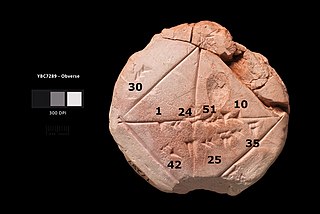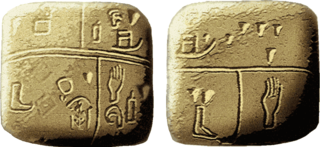
A numeral system is a writing system for expressing numbers; that is, a mathematical notation for representing numbers of a given set, using digits or other symbols in a consistent manner.
1 is a number representing a single or the only entity. 1 is also a numerical digit and represents a single unit of counting or measurement. For example, a line segment of unit length is a line segment of length 1. In conventions of sign where zero is considered neither positive nor negative, 1 is the first and smallest positive integer. It is also sometimes considered the first of the infinite sequence of natural numbers, followed by 2, although by other definitions 1 is the second natural number, following 0.

Roman numerals are a numeral system that originated in ancient Rome and remained the usual way of writing numbers throughout Europe well into the Late Middle Ages. Numbers are written with combinations of letters from the Latin alphabet, each letter with a fixed integer value. Modern style uses only these seven:
0 (zero) is a number representing an empty quantity. Adding 0 to any number leaves that number unchanged. In mathematical terminology, 0 is the additive identity of the integers, rational numbers, real numbers, and complex numbers, as well as other algebraic structures. Multiplying any number by 0 has the result 0, and consequently, division by zero has no meaning in arithmetic.
Sexagesimal, also known as base 60, is a numeral system with sixty as its base. It originated with the ancient Sumerians in the 3rd millennium BC, was passed down to the ancient Babylonians, and is still used—in a modified form—for measuring time, angles, and geographic coordinates.

Babylonian cuneiform numerals, also used in Assyria and Chaldea, were written in cuneiform, using a wedge-tipped reed stylus to print a mark on a soft clay tablet which would be exposed in the sun to harden to create a permanent record.
Greek numerals, also known as Ionic, Ionian, Milesian, or Alexandrian numerals, are a system of writing numbers using the letters of the Greek alphabet. In modern Greece, they are still used for ordinal numbers and in contexts similar to those in which Roman numerals are still used in the Western world. For ordinary cardinal numbers, however, modern Greece uses Arabic numerals.
A binary number is a number expressed in the base-2 numeral system or binary numeral system, a method of mathematical expression which uses only two symbols: typically "0" (zero) and "1" (one).
A numerical digit or numeral is a single symbol used alone or in combinations, to represent numbers in a positional numeral system. The name "digit" comes from the fact that the ten digits of the hands correspond to the ten symbols of the common base 10 numeral system, i.e. the decimal digits.

Cuneiform is a logo-syllabic writing system that was used to write several languages of the Ancient Near East. The script was in active use from the early Bronze Age until the beginning of the Common Era. Cuneiform scripts are marked by and named for the characteristic wedge-shaped impressions which form their signs. Cuneiform is the earliest known writing system and was originally developed to write the Sumerian language of southern Mesopotamia.
In linguistics and semiotics, a notation system is a system of graphics or symbols, characters and abbreviated expressions, used in artistic and scientific disciplines to represent technical facts and quantities by convention. Therefore, a notation is a collection of related symbols that are each given an arbitrary meaning, created to facilitate structured communication within a domain knowledge or field of study.

Positional notation usually denotes the extension to any base of the Hindu–Arabic numeral system. More generally, a positional system is a numeral system in which the contribution of a digit to the value of a number is the value of the digit multiplied by a factor determined by the position of the digit. In early numeral systems, such as Roman numerals, a digit has only one value: I means one, X means ten and C a hundred. In modern positional systems, such as the decimal system, the position of the digit means that its value must be multiplied by some value: in 555, the three identical symbols represent five hundreds, five tens, and five units, respectively, due to their different positions in the digit string.

The Proto-Elamite script is an early Bronze Age writing system briefly in use before the introduction of Elamite cuneiform.

Babylonian mathematics is the mathematics developed or practiced by the people of Mesopotamia, from the days of the early Sumerians to the centuries following the fall of Babylon in 539 BC. Babylonian mathematical texts are plentiful and well edited. With respect to time they fall in two distinct groups: one from the Old Babylonian period, the other mainly Seleucid from the last three or four centuries BC. With respect to content, there is scarcely any difference between the two groups of texts. Babylonian mathematics remained constant, in character and content, for over a millennium.
Non-standard positional numeral systems here designates numeral systems that may loosely be described as positional systems, but that do not entirely comply with the following description of standard positional systems:
Number systems have progressed from the use of fingers and tally marks, perhaps more than 40,000 years ago, to the use of sets of glyphs able to represent any conceivable number efficiently. The earliest known unambiguous notations for numbers emerged in Mesopotamia about 5000 or 6000 years ago.
An alphabetic numeral system is a type of numeral system. Developed in classical antiquity, it flourished during the early Middle Ages. In alphabetic numeral systems, numbers are written using the characters of an alphabet, syllabary, or another writing system. Unlike acrophonic numeral systems, where a numeral is represented by the first letter of the lexical name of the numeral, alphabetic numeral systems can arbitrarily assign letters to numerical values. Some systems, including the Arabic, Georgian and Hebrew systems, use an already established alphabetical order. Alphabetic numeral systems originated with Greek numerals around 600 BC and became largely extinct by the 16th century. After the development of positional numeral systems like Hindu–Arabic numerals, the use of alphabetic numeral systems dwindled to predominantly ordered lists, pagination, religious functions, and divinatory magic.

The proto-cuneiform script was a system of proto-writing that emerged in Mesopotamia, eventually developing into the early cuneiform script used in the region's Early Dynastic I period. It arose from the token-based system that had already been in use across the region in preceding millennia. While it is known definitively that later cuneiform was used to write the Sumerian language, it is still uncertain what the underlying language of proto-cuneiform texts were.








